The GPT-5 Launch: OpenAI Ushers in a New Era of Artificial Intelligence
The world of technology is buzzing with what is undoubtedly the most significant AI news of the year: the official GPT-5 Launch. After months of speculation and anticipation, OpenAI has finally pulled back the curtain on its next-generation language model, and the revealed capabilities are set to redefine the boundaries of human-computer interaction. This isn’t just an incremental update; the GPT-5 Launch represents a monumental leap forward, promising to transform industries, empower creators, and fundamentally change how we interact with the digital world.
For those who follow AI news closely, the event, livestreamed from OpenAI’s headquarters, was a showcase of innovation. CEO Sam Altman presented a model that is not only more powerful and accurate but also fundamentally more integrated and aware. This article will break down the groundbreaking features announced during the GPT-D Launch, analyze their potential impact, and explore what this milestone means for developers, businesses, and everyday users.
What Was Announced at the Official GPT-5 Launch?
The core of the GPT-5 Launch event was the live demonstration of the model’s new, revolutionary features. OpenAI has moved beyond simply enhancing text generation and comprehension. GPT-5 is engineered as a comprehensive reasoning engine, capable of understanding context and executing tasks with a level of autonomy that was previously the domain of science fiction.
Key announcements from the GPT-5 Launch include:
- Real-Time Data Integration: GPT-5 is no longer limited by a knowledge cut-off date. The new model can access and process information from the internet in real-time, allowing it to provide up-to-the-minute answers, analyze current events, and engage with live data streams. This is a game-changer for financial analysis, journalism, and research.
- Advanced Multimodality: While GPT-4 could process images, GPT-5 takes multimodality to an entirely new level. It can natively understand and process video, audio, and even basic 3D schematics. During the demo, the model was shown describing the action in a video clip, transcribing a conversation with multiple speakers, and suggesting structural improvements to a 3D model—all within a single prompt.
- Autonomous AI Agents: Perhaps the most groundbreaking feature is the ability to deploy GPT-5 as an autonomous agent. Users can assign complex, multi-step goals, and the model will independently formulate and execute a plan to achieve them. This could involve Browse the web, writing and debugging code, interacting with APIs, and delivering a final, comprehensive result without step-by-step human guidance.
A Deeper Dive into GPT-5’s Groundbreaking Features
Understanding the significance of the GPT-5 Launch requires a closer look at these core features. The shift to real-time data integration directly addresses one of the biggest limitations of previous models. Imagine asking an AI to write a market analysis report that includes today’s stock market fluctuations or to summarize a political debate that just concluded. This capability transforms GPT-5 from a static knowledge base into a dynamic, aware intelligence partner. This development is huge AI news for professionals who rely on timely information.
Advanced multimodality, meanwhile, opens up creative and analytical possibilities we are only just beginning to imagine. A filmmaker could upload a rough cut and ask GPT-5 to suggest pacing improvements or generate a fitting musical score. An architect could show it a blueprint and have it identify potential design flaws. The GPT-5 Launch signals a move toward a more holistic form of artificial intelligence—one that perceives and interacts with the world in a way that is much closer to human cognition.
However, it is the introduction of autonomous AI agents that truly sets the GPT-5 Launch apart. This functionality allows the model to act as a project manager or a personal assistant on steroids. For example, a developer could task a GPT-5 agent with “building a simple e-commerce website, finding a suitable hosting provider, and deploying it.” The agent would then break down this goal into sub-tasks—generating code, researching hosting reviews, interacting with the hosting service’s API—and execute them sequentially. This feature alone has the potential to skyrocket productivity and democratize skills that were once highly specialized.
The Impact of the GPT-5 Launch Across Industries
This major AI news will have ripple effects across every sector. In healthcare, doctors could use GPT-5 to analyze real-time patient data alongside the latest medical research to suggest diagnoses. In education, it could function as a personalized tutor for students, adapting its teaching style and content based on the student’s real-time progress and understanding.
The creative industries will be profoundly affected. Musicians, writers, and designers will have a powerful collaborator capable of contributing to their work in unprecedented ways. For businesses, the implications are vast—from hyper-personalized customer service agents that can solve complex problems to fully automated supply chain management. The GPT-5 Launch is not just another software release; it’s the introduction of a new, universally applicable utility.
Conclusion: A New Chapter in Artificial Intelligence
The GPT-5 Launch has delivered on its promise and exceeded the expectations of many. It marks a pivotal moment in the ongoing story of artificial intelligence, shifting the paradigm from assistive tools to collaborative, autonomous partners. The combination of real-time awareness, advanced multimodal understanding, and agentic capabilities makes GPT-5 a truly revolutionary technology. As this model becomes accessible to developers and the public, it will undoubtedly unleash a wave of innovation. This is the kind of transformative AI news that will be remembered for years, marking the beginning of a new chapter in our relationship with technology.
Sources:
- OpenAI. (2025, August 5). Introducing GPT-5: The Next Era of AI. OpenAI Official Blog.
- Thompson, Alex. (2025, August 5). “OpenAI’s GPT-5 Can See, Hear, and Act: Here’s What Happened.” TechCrunch.
- Chen, L. et al. (2025). Autonomous Agentic Architectures in Large Language Models. arXiv.org.
